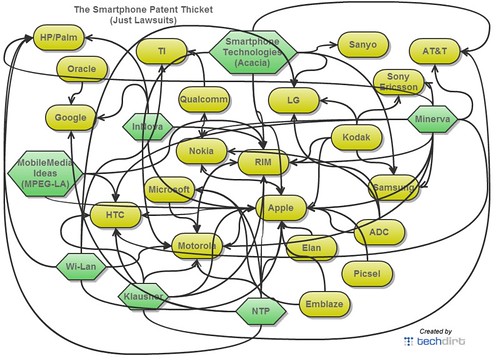Why The Answer To The Smartphone Patent Thicket Is Not A Patent Pool
from the sorry,-but-no-thanks dept
We recently wrote about the incredible patent thicket in the smartphone space. For some reason, in the course of a few days, about ten different publications all created a very similar graphic about "who was suing whom" in the smartphone space for patent infringement. Unfortunately, most of those graphs had the wrong data and/or did not include non-practicing entities, who make up some of the most serious (and expensive) lawsuits in the space, and are certainly an important part of understanding the thicket. We created our own graphic here:
We've heard this before, and explained before why patent pools aren't a really good solution. In fact, two years ago we pointed to new research showing evidence for why that famed sewing machine patent pool actually did more to hinder innovation than to encourage it. As we explained at the time:
First, companies scramble to get patents that can be included in the patent pool (rather than focusing on actually innovating in the market and understanding what the market wants). Once the pool is truly established, patenting decreases, because it's just not worth it to compete. After the patent pool dissolves, then others finally get back into the market. Second, because the patent pool locks in the effective "standard" early in the process, it might not actually be the best technology. In their research, Lampe and Moser found that this is exactly what happened with the first patent pool concerning the sewing machine. It "shifted the direction of innovation to an inferior technology... which was known to be significantly less robust, and unsuitable for mass production."Are patent pools better than the legal jumble of lawsuits from the graphic above? Maybe. But are they the best solution out there? Absolutely not. Instead, a better solution would be to just let the market compete on the merits of the products and let the market decide, rather than focusing on any monopoly rights that will exclude innovators.
Then, once they're in the patent pool, they become anti-competitive: suing any upstart that tries to innovate and is not a member of the patent pool. So, effectively, rather than innovating, they use the patent pool to block any competition. Finally, once the patent pool is in place, the companies involved decrease their own pace of innovation, because they've basically just blocked out the competitors. Thus, they don't need to keep innovating at the same pace.
Filed Under: competition, innovation, patent pool, patents, sewing machine, smartphones

